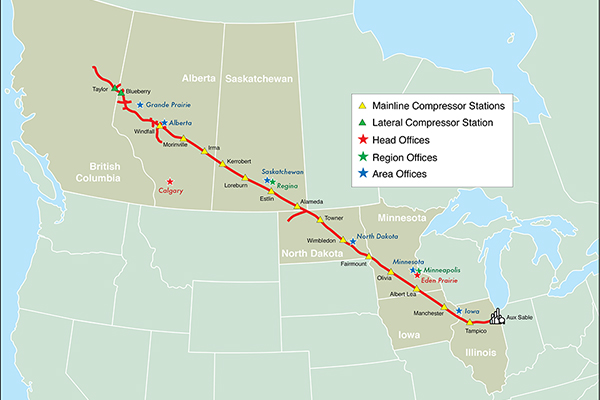Market Snapshot: The Alliance Pipeline’s rising heat content highlights its unique role in Canadian natural gas exports
Release date: 2015-07-09
Natural gas produced from oil and gas wells primarily consists of methane but can also contain natural gas liquids (NGLs) like ethane, propane, and butane. Because NGLs burn hotter than methane on a per volume basis, gas that is “rich” in NGLs has higher heat content than “lean” gas.
The heat content of the natural gas being received on the Alliance Pipeline System in Alberta and British Columbia (B.C.) has been increasing since 2013, from about 40.5 gigajoules per thousand cubic metres (GJ/1000m³) to over 41.5 GJ/1000m³, indicating that the concentration of NGLs in the natural gas stream has been growing over time. In comparison, other pipelines that export natural gas from Western Canada have heat contents of approximately 38.5 GJ/1000m³. Alliance’s gas-gathering area is located where exploration companies have been increasingly targeting rich gas because of the extra revenue they can earn on the co-produced NGLs, thus causing Alliance’s heat content to rise.
Figure Sources and Data
Sources: Alliance, NEB calculations
Description: This chart illustrates the monthly heat content of the Alliance Pipeline’s receipt volumes from Alberta and B.C. from January 2012 to May 2015. The monthly heat content is calculated by dividing Alliance’s received volumes for each month by their total energy, both of which are obtained from Alliance’s Monthly Pipeline Throughput Summary reports. The chart shows how the heat content on Alliance in Alberta and B.C. was fairly constant in 2012, but started to increase steadily over the past two years. The heat content of gas receipts from Alberta increased from 40.40 GJ/1000m³ in January 2012 to 40.57 GJ/1000m³ in January 2013 and 41.59 GJ/1000m³ in the most recent month of May 2015. The heat value of gas receipts from British Columbia increased from 40.33 GJ/1000m³ in January 2012 to 40.41 GJ/1000m³ in January 2013 and 41.82 GJ/1000m³ in the most recent month of May 2015.
Pipelines that ship natural gas out of Western Canada, other than Alliance, must do so with the gas in a regular gaseous state. These pipelines require gas to have lower heat contents, because NGLs can otherwise condense and form liquid droplets in the natural gas stream. Any such misting of the natural gas stream has to be avoided, as it would lower efficiencies and even damage equipment. Most of the NGLs are removed from the gas stream in Western Canada by gas-processing plants (including straddle plants) for use in local markets.
Figure Source and Description
Source: Alliance
Description: This map shows the location of the Alliance Pipeline System across North America, including head offices and mainline compressor stations.
The Alliance System on the other hand, is unique for a Canadian natural gas pipeline because it ships gas in a high pressure "dense-phase" along the transmission mainline. Compressors on the Alliance mainline increase the gas pressure while cooling bays control the temperature until the natural gas enters a dense phase and will not condense. Alliance can therefore handle higher concentrations of NGLs because the mixture of hydrocarbons, including the methane, exists in this dense phase. This also means shippers on Alliance are able to move minimally-processed rich gas out of Western Canada to Aux Sable’s gas-processing facility near Chicago, where the NGLs are then stripped out. The processed natural gas and the NGLs are then sold to Midwest and eastern markets.
- Date modified:

